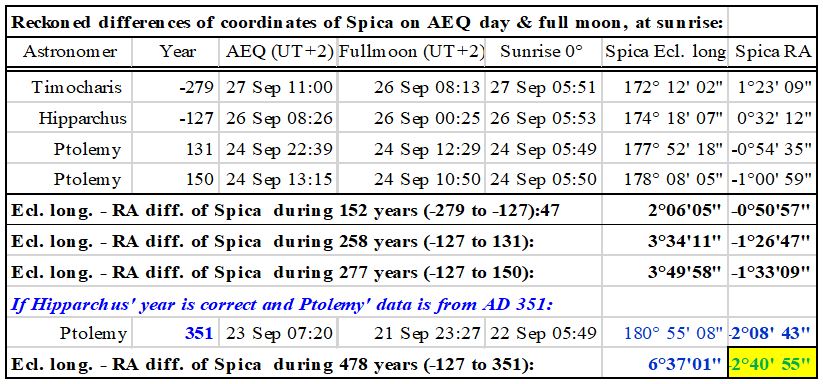
It seems that a period was prolonged after the fall of the Western Roman Empire. But I can imagine that at the same time, an earlier period was also “pressed together”, like wine grapes… Of course, from this “pressed period” remained only its essence. Let us see why and how was it astronomically feasible to shrink an older period.
I have extended the insights of Thompson and the other scientists above as follows:
I have assumed that Ptolemy, or rather Hipparchus himself, converted the difference in celestial coordinates in general from RA to Ecl. long. coordinate. This assumption is justified because of 2° Ecl. long. is a better illustration of precession since 2° is precisely a “round fraction”, 1/180th of the total angular rotation of precession of 360° Ecl. long.
I also assumed that the 2°40′ difference for the period 128BC – AD131 (or AD131) described by Ptolemy “remained somehow” in RA coordinates.
Ptolemy had left by mistake the angular rotation of Spica in RA, or had deliberately changed it to RA. It is also possible that this data retroactively (even centuries later) have been transformed, by mistake or intentionally to RA. After all, the very important original works somehow "disappeared"!?
Ptolemy also wrote about the trigonometric transformability of celestial coordinates, for which Hipparchus developed the “chords” procedure. (Not incidentally, the genius Hipparchus is also the father of trigonometry.)
It is easy to find out today that the equivalent of 2°40' RA is 6°34' Ecl. long. Obviously, an angular rotation of 6°34' Ecl. long. corresponds to a much longer period than 265 years. It results in around 480 years! Expressed in precession, this makes round: 1°/73 years angular velocity or 26.280 years cycle! A reasonable approximation compared to today's parameters! Not like the one attributed to Almagest (min) 1°/100 years and (max) 36.000 years!
So, to continue our train of thought, let us accept that Hipparchus’ years are astronomically in their correct year. (Year of his measurement 128BC). This is also acceptable because Hipparchus’ years fit well into the (from Rome) independent early relative chronology of ancient Greek history before the Roman conquest, within which it could hardly be misinterpreted.
Let us also assume that Ptolemy’s “own” data came from a year of AEQ & full moon simultaneity. So, we temporarily accept as Ptolemy’s measurement year the previously proposed year AD131 instead of AD138.
The only year (after 128BC) corresponds well to 6°34' Ecl. long. precession angular rotation, as well as the coincidence of AEQ & full moon, is: AD351. The recalculated angular rotation is for the period 128BC - AD351: 2°40'55" RA = 6°37'01" Ecl. long. It also follows that 2°40' RA was measured quite accurately in antiquity. It appears that someone could have "misinterpreted" 2°40' RA as Ecl. long. or changed it to Ecl. long!
Let us see all these in detail below:

Table 6. (Author’s calculations based on Stellarium.)
If the year of Hipparchus’ measurement (-127= BC128) is correct and the year of Ptolemy’s measurement was AD351 instead of AD131, as I had previously assumed, then Ptolemy’s real, original years have, for some reason, been shifted back precisely 220 years (from AD351 to AD131) along the time axis.
The Almagest dates from AD370, not from AD150! The Era of Ptolemy has become due to backwards shifting closer in AD time to the years of Hipparchus than it really was. The time difference between Hipparchus and Ptolemy has "shrunk" by 220 years. This "shrinkage" may be due to the centuries later "extension" of an epoch by 220 years,as assumed in the current hypothesis.
I note that the “shrinking” of a long past period is more difficult to recognise retrospectively as the “extension” of a younger period. The original state is more difficult to reconstruct than it is in the case of the “stretching” of a later period.
If an old year (such as the year 128BC of Hipparchus) lies correctly in the AD system, then the insertion of an extended period (such as the 200 years of Hunnivári and the 247 years of Szekeres) must be accompanied by a shortening of an earlier period. The authors of these earlier theories do not mention the possibility of a similar shrinkage of an earlier period!
Following in the footsteps of Exiguus and Beda and accepting their data, later historians “quasi automatically” shortened the period of ancient Greek and Egyptian history before the Roman occupations. An earlier period of history in these regions had been compressed.
To mislead later historians, all that was needed was to “remove” the historical descriptions of some earlier “historical key events”, thus “erasing the past”. Only some old documents relating to Greek and Egyptian history had to be removed or destroyed. The removal and destruction had been “supported” by the serial and supposedly deliberate burning and then final destruction of the famous library of Alexandria (Musaeum) in the 7th century! Shortly before the period of forgery that I assume…

My note: Another possible way of solving the issue of precession objection is to assume that the era of Hipparchus and Timocharis was 220 years closer to the present as we date it now. In this case, we must assume that the speed of precession is not quasi-constant, but that it was for some reason greater in antiquity than in the present.
